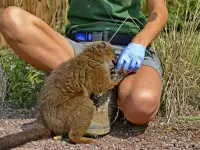
Biostatistics is a specialized branch of the statistics field that collects and examines data related to living things.
What Does a Biostatistician Do?
Biostatisticians analyze data and statistics on living things collected during medical research studies to draw conclusions or make predications. They may also contribute to the design and execution of research studies in collaboration with other statisticians and scientists. During the execution of the clinical trial, some may monitor how the study is conducted to ensure that the integrity of the results won't be compromised. Writing research proposals and conveying their findings to the scientific community is another important part of their job. Some Biostatisticians may also teach at universities while conducting their research.
Performing fieldwork and collecting data is also an important aspect of the job.
Where Does a Biostatistician Work?
Biostatisticians spend the greater part of their workdays in an office setting, typically working on a computer. Becoming familiar with specialized programs used to analyze statistics and lab results will be extremely useful for this field. They will often be required to collaborate with a team of scientists and researchers, meaning that they spend a great deal of their day interacting both in person and through phone and email. Some Biostatisticians that are employed by universities will spend a good portion of their time in a lab, as well as the classroom.
Most of these professionals work full-time on a normal daytime schedule. If a particular project is nearing its deadline or is overdue, then overtime may be required.
What Is the Average Biostatistician Salary?
Biostatisticians earn a median salary of $93,290. Within this broad category, mathematicians earn a median salary of $110,860, while statisticians earn a median of $92,270.*
Most Biostatisticians work for the Federal government at the Census Bureau, Bureau of Economic Analysis, or other special departments. However, others work for private finance companies and educational services.
What Is the Job Demand for Biostatisticians?
The job demand for biostatisticians is expected to grow 33% in the next 10 years (2020-2030), which is much faster than other professions.* These kinds of statisticians are increasingly needed in the medical field, particularly in the pharmaceutical industry where they can help conduct research and run clinical trials for innovative medicines and health technologies.
Biostatistics Jobs
Biostatisticians conduct research into relationships between two or more sets of biological data. Through jobs for biostatisticians vary from role to role and across industries such as biological and agricultural science, business and economics, physical and social sciences as well as engineering, many responsibilities are similar. Biostatistician jobs require that candidates:
- Have expert knowledge of statistics, mathematics, and computer science to analyze large data sets
- Engage in data extraction, storage, initial analysis, and delivery to users
- Participate in the planning stages of research, as well as the data collection and interpretation stages
Lead the implementation, analysis and interpretation of studies within the scope of the project - Link to and develop complex databases and data analysis programs
- Develop analysis plans and methodologies, as well as conduct analysis of datasets
- Develop new algorithms, statistical techniques, and visualization approaches so that workgroup, and stakeholders can implement findings
- Provide statistical expertise and peer teaching to internal and external partners
- Construct and critique scientific manuscripts and grant applications
- Prioritize tasks within a given framework; meet agreed-upon milestones and timelines independently and collaboratively
Senior Biostatisticians often have enhanced job responsibilities that help manage the department or workgroup's budget and collaborative concerns. Such responsibilities often include:
- Ensuring that systems and methods of design, planning, data analysis, modeling and projections, associated documentation and development meet the goals of the workgroup and stakeholders
- Assisting and mentoring team members
- Engaging in decision making at project level
- Establishing valid and efficient statistical protocols
- Exercising initiative in handling complex special projects
- Composing scopes of work, statistical memos and reports
- Reporting on findings for analysis and conclusions to internal and external meetings and conferences
- Supporting team members' statistical research by providing mentoring
- Contributing to computational aspects of statistical scientific content for internal and external stakeholders
- Providing assistance for data representation and interpretation for internal and external publications
What Are the Education Requirements to Become a Biostatistician?
Biostatisticians generally hold degrees in higher education. To begin working towards breaking into this career, you must first obtain a bachelor's degree in biostatistics, statistics, or math. Taking other classes that focus on medicine or biology will also be helpful for future study.
Though there are some entry-level positions open for those holding bachelor's degrees, most Biostatisticians go on to achieve their master's or doctorates. These degrees help students become specialized and give them more experience with conducting research and presenting results.
Degrees Related to Biostats
What Kind of Societies and Professional Organizations Do Biostatisticians Have?
Biostatisticians and those who wish to enter the field can also browse through these government websites and organizations for valuable resources:
- U.S. Food and Drug Administration (FDA) is a federal agency that approves and authorizes the sale of certain foods and pharmaceuticals. The FDA is responsible for ensuring that the products that the American people are consuming are safe. Biostatisticians may use their rules and regulations as a reference point for conducting clinical trails. They may also use this website to obtain a job with the Federal government or stay abreast of current news in the medical community.
- International Society for Clinical Biostatistics (ISCB) is a professional society that brings Biostatisticians together from across the globe to bolster medical research, share ideas internationally, and discuss the future of the field. Members have access to many different conferences and events around the world, as well as special publications and job opportunities.
- American Statistical Association (ASA) is a more general professional society targeted towards those in the statistical profession, including biostatics. They promote the development of current and future statisticians through professional awards, industry-specific publications, education efforts, and annual meetings. They even provide a career center to help budding statisticians find a job.
*2020 US Bureau of Labor Statistics salary figures and job growth projections for mathematicians and statisticians reflect national data not school-specific information. Conditions in your area may vary. Data accessed September 2021.





